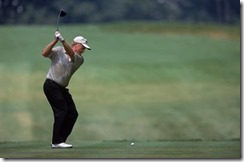Backswing Secrets of the Pros
Ever watched a pro play? Did you get the feeling that he/she was merely stretching lazily on the backswing – without expending any effort whatsoever? There’s a reason almost all pro swings look that way. It is called SYNCHRONIZATION. It works something like this:
Synchronize your ARMS Swing and your Shoulder TURN
Too often, amateurs swing their arms faster than they initiate their shoulder turn. Or the reverse – they aggressively turn their shoulders with the arms lagging behind. And almost without fail, most amateurs will overswing (arms) , under-turn (small shoulder turn) – or a combination of the two.
You will never see a pro do that – A pro starts turning her shoulders just as the left arm starts swinging the club back. Everything together!
Keep the left ELBOW down on the takeaway
Surprisingly, your LEFT elbow (and your right foot) have a lot to do with executing this ‘synchronized’ turn.
If your left elbow keeps pointing to target (as a lot of misleading instruction will suggest), your shoulders will turn on a flat plane. In order for your shoulders to turn on an inclined plane (around your spine), your left elbow NEEDS to point downwards (more accurately, at the target line). Not only will this turn the shoulders on the correct plane, the left elbow will help UNITE your shoulders and your arms. You should feel more connected as you turn back – which will help you synchronize the arms with the shoulders.
The club STAYS between the arms all the way to the top
At address, the club shaft rests between your arms (i.e. it is not outside either the left or the right arm, it is somewhere in between).
The club needs to continue staying between the arms even on the backswing! Keeping the club between the arms will force you to synchronize your shoulder-turn and your arm-swing. If either one tries to overtake the other, the shaft will no longer be ‘in between the arms’.
This is a key backswing thought, that in itself, will help straighten out your shots. On the top of the backswing, your shaft should be almost bisecting the two arms (dead center of both arms).
See Jack Nicklaus demonstrate this below:
Practice Tip – Keep your right foot planted
It is difficult, if not impossible, to keep everything in sync if you are constantly losing your balance. Keeping your balance essentially means keeping your right foot planted, as your upper body executes its turn.
Keeping the right foot planted on the backswing (and the first part of the downswing) – is something that every pro works on. This RIGHT foot planted is a little difficult to achieve for amateurs. I found a good tip on youtube – essentially, place an alignment rod on the ground – running perpendicular to the target line. Place your right foot on this rod – and swing back, keeping your right foot on the rod. If you can keep your foot from rolling off the rod, you will be a step closer to keeping it planted on the backswing and downswing.
Pause on Top
Several of my coaches asked me to PAUSE on the top of the backswing. This momentary pause need not be an ACTUAL pause – it just needs to be a MENTAL pause. You just need to signal to your brain that the backswing is complete. As you develop a sense of coordinating the arms (swing) with the shoulders (turn), you will find this ‘completion point’ to be an important aspect of the backswing. This ‘top of the backswing’, will help you sense if the arms and the shoulders are actually completing the backswing in unison.
This ‘simultaneous completion’ is what you are aiming for – and what every pro executes perfectly on every swing. This is also what makes the backswing look effortless.
Summary
If you can co-ordinate your arm motion with your shoulder motion, you will find yourself making a simple and efficient backswing. You will notice that your arms stop swinging at the same time as the shoulders stop turning. This primes you perfectly at the top; from here the downswing should be automatic. However, a good swing thought is to start your downswing in ONE PIECE as well.
In my opinion, if you master the backswing, you will have mastered the entire golf swing. The downswing is mainly a reflex action to a well executed backswing. Keeping the right foot planted on the backswing and the first part of the downswing – is a key that will help you accomplish this ‘turning in unison’. It is something that most pros work on – and not something that you will learn without getting an elaborate set of golf lessons!
Keep your right foot planted, turn everything back in unison – so your arms finish the backswing at the same time as the shoulders.

Is the correct hingeing of the wrists more of a natural response to the swinging head weight rather than something deliberately applied?
I know the softer I “try”, the shots are better for it.
Yes, the hinging should be an effect, not something deliberately produced.
The correct hinge is ‘lateral’
https://www.anujvarma.com/lateral-wrist-break-hinge-with-a-rounded-shoulder-turn/